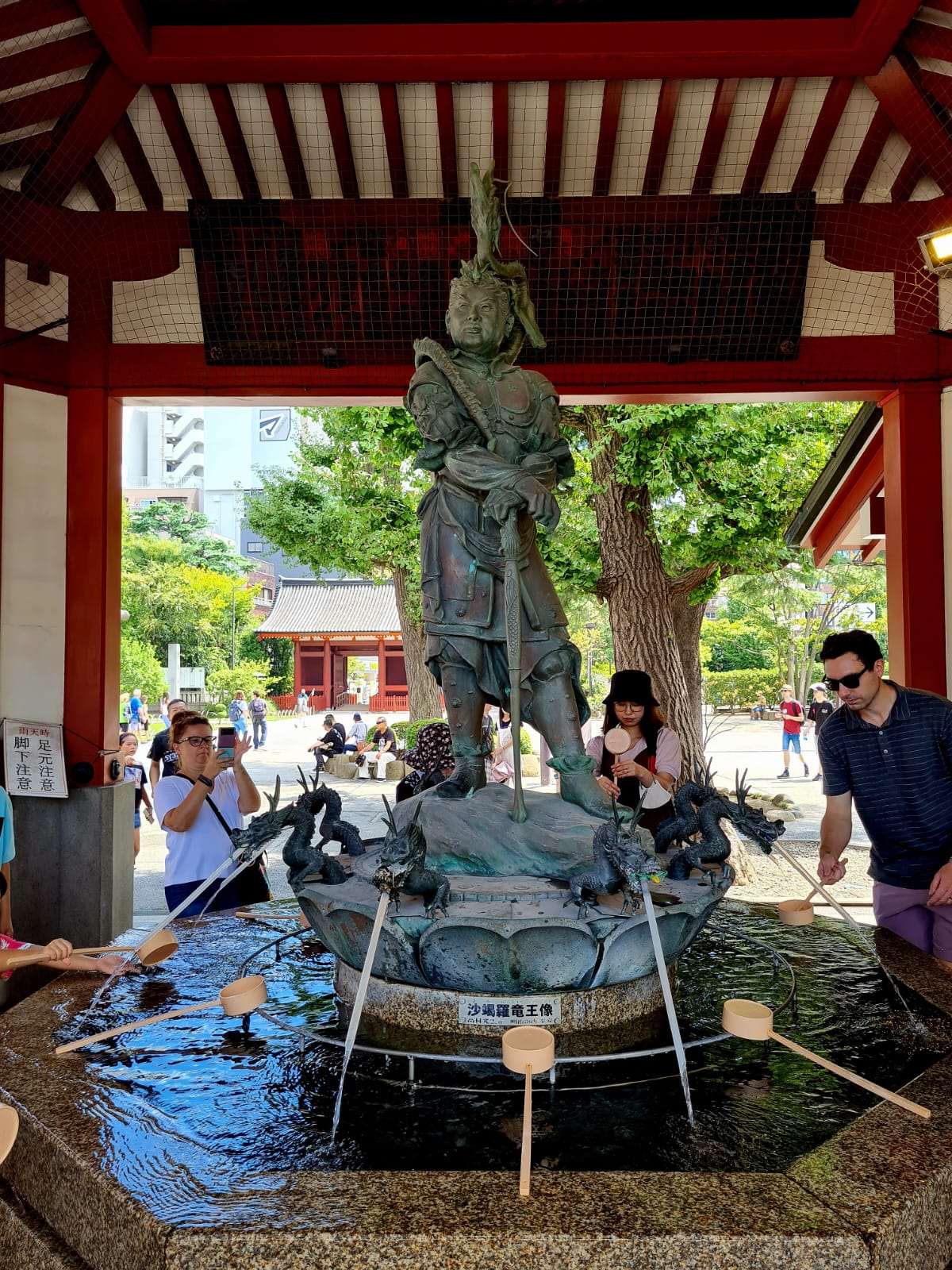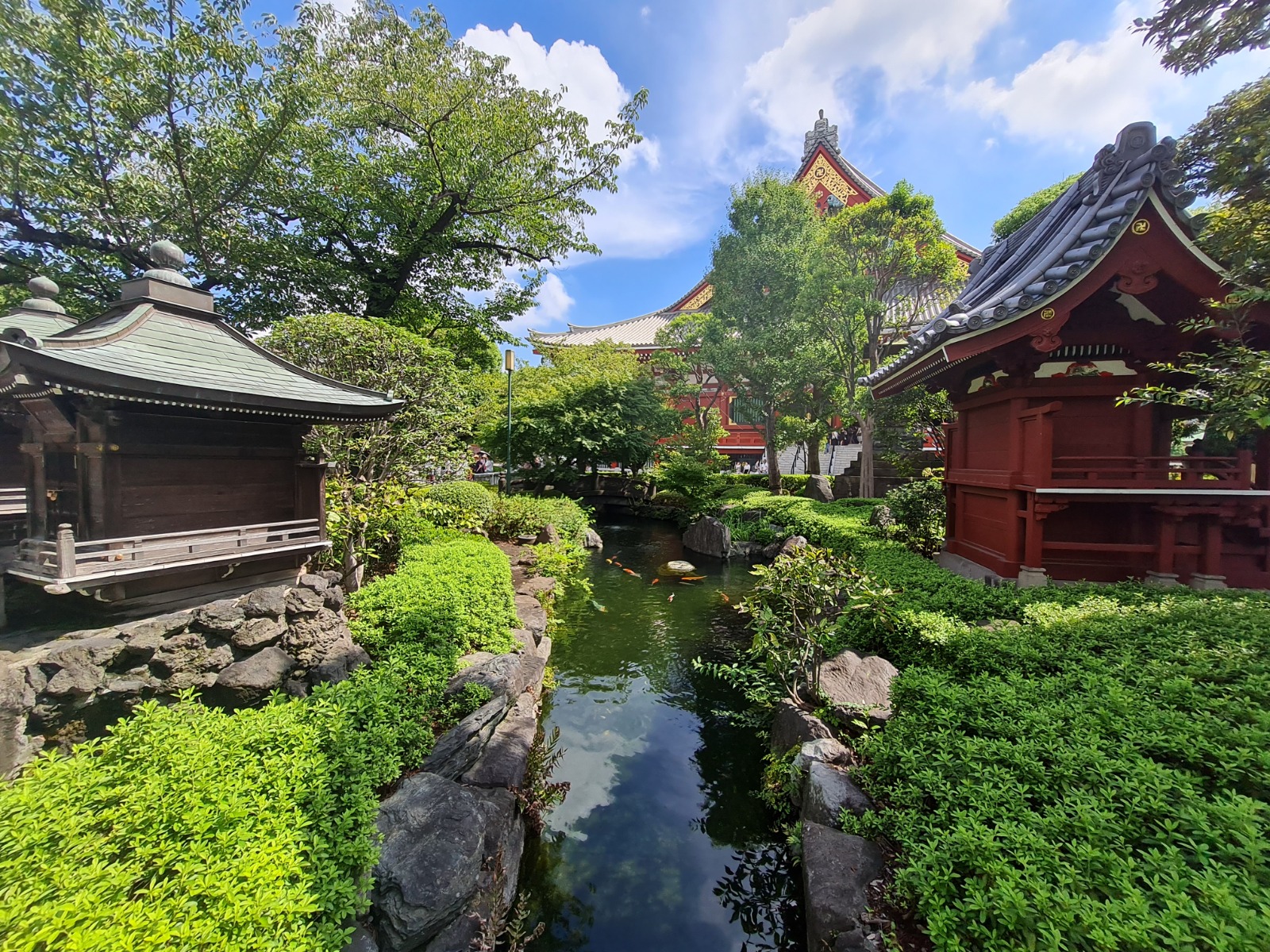Tokyo is Japan’s capital city and is one of the world’s most populous cities with 14 million residents in 2023 and the world’s most populous metropolitan area with over 40 million residents in 2023. It is crowded!
Tokyo was previously called Edo but was renamed Eastern Capital when the emperor and capital moved from Kyoto to Tokyo during the Meiji Restoration in 1868. Large parts of the city were destroyed in the Great Kanto Earthquake in 1923 and in the WWII air raids of 1945. Today Tokyo is a fusion of temples, historical areas, business and shopping districts, modern buildings, a hip dining scene, and also attractive green spaces and city parks all within easy access of an incredible public transport network.
Tokyo is an awesome but crazy busy city. Every moment of every day everywhere is super crowded. We are glad we ended the trip here rather than starting it here, it would have been very overwhelming otherwise. We had many quiet and peaceful moments in all the other cities, but that’s not possible in Tokyo.
We arrived in Tokyo earlier in the day than initially planned due to our Lake Kawaguchiko day being rained out thanks to the typhoon and thus still had a full afternoon ahead of us. The weather was still hot but felt slightly cooler than Osaka and Kyoto, possibly leftover coolness from the typhoon.
First up was Shibuya, the financial and commercial centre on the western side of Tokyo. The area is best known for the Shibuya Scramble crossing in front of Shibuya station that feels a lot like Times Square in New York or Piccadilly Circus in London with all its brightly lit neon sign boards. Shibuya Crossing is the world’s busiest pedestrian crossing allowing ~3000 people to cross the intersection in all directions every two minutes. It starts very calm but soon turns into a scramble as everyone tries to get across before the light changes. The sidewalks start empty but by the time the light changes it’s filled up to capacity again almost spilling over onto the street. Estimates say that ~260 000 pedestrians use the crossing on weekdays and ~390 000 on non-working days. That is a staggering number of people for a pedestrian crossing! We walked over twice and it really is that crazy! Can be a bit scary too.
At the Shibuya crossing is also the statue of Hachiko, a Japanese Akito dog who faithfully waited at the station everyday for his human. His owner passed away unexpectedly at work one day in May 1925 but Hachiko still waited at the station for him at the same time every afternoon until his own death almost a decade later in March 1935. He has since become a national symbol of family loyalty. This bronze statue was erected in his honour and is a popular meeting point at the station.
After a fab but unexpected lunch at a more western lunch style sandwich and smoothie place, we continued on to Meiji Jingu Temple. Meiji Jingu is a Shinto Shrine dedicated to the deified spirits of Emperor Meiji and his wife Empress Shoken who led Japan to become a modernised nation. The temple is in a 70 hectare man made forest with 120 000 trees donated from all over Japan and is adjacent to Yoyogi Park making up a larger forested green space area in Shibuya District. The temple was commissioned when the emperor passed away in 1912 and officially opened in 1920. The original temple was destroyed by air raids in WWII and the current structure was completed in 1958.
Even though it was very busy at the shrine and grounds, it was also really peaceful as the approach to the temple is a walk through the forest. We enjoyed the forest, the enormous Torii gates, and were surprised by a massive wall of large barrels of sake donated to the temple. We wanted to go to the inner garden but it was already closed for the day.
From the temple, we made our way back to Tokyo central station for dinner at Ramen Street, a street under the station filled with ramen restaurants. There is also Character Street nearby with stores dedicated to various cartoon characters from Winnie the Pooh to Pokemon to Hello Kitty and everything inbetween.
Tokyo main station is insane! Out hotel was inbetween main station and Kanda station, we predominantly used Kanda as main station was just too intense lol. Main station is just massive and we found it really confusing, there was also some construction works underway which was not helpful. But if you used the station frequently and became more used to it, it’s probably a very cool station. Just for passing through, its really intense.
The next day started at Senso-ji temple. Senso-ji is an ancient and important Buddhist temple dedicated to Kannon, the Buddha of compassion and mercy. It is Tokyo’s oldest temple, originally completed in 645 but destroyed in WWII and rebuilt after the war. Kaminarimon or Thunder Gate is the impressive massive outer gate of the temple complex. Stepping through this gate leads into Nakamise-dori, a long street lined with stores leading to the main temple buildings. Historically these stores served the needs of the worshippers visiting the temple but these days have become a bit touristy. At the end of the street is another large entrance gate, Hozomon with the traditional Nio statues and two large 4.5 m sandals. Going through this gate leads to the main temple hall, a 5 storey pagoda, and the temple grounds. There were also lots of smaller shrines, significant rocks, and water features around the main temple area. The temple receives ~30 million visitors annually, it was pretty crowded when we were there but not too crazy.
The rest of the day was spent at Ueno Park. Ueno Park is a spacious public park with multiple museums, statues, a zoo, and a popular spot to enjoy cherry blossoms in the spring. The park was established in 1873 on grounds formerly belonging to Kanei-ji Temple and was one of Japan’s first public parks. It was a Sunday and it was lovely to see Tokyo locals enjoying the green spaces with their families.
We started at Ueno Station and entered the park near the bronze statue of Saigo Takamori, an influential samurai and one of the three nobles who led the Meiji Restoration. We enjoyed the Shinobazu Pond and strolled all the way through the park to the National Museum also passing the statue of Prince Komatsu Akihito on his horse. We wanted to go to the Shitamachi Museum with a recreation of old downtown Tokyo through different eras, but it is temporarily closed until March 2025.
It was already late afternoon so we headed back to our hotel and looked for something other than our staple of noodles and stumbled on gyoza, a popular dumpling that we hadn’t actually seen in Japan yet. We didn’t realise it was a bit of a dodgy upstairs pub but it turned out to be just fine. There were only two other tables when we arrived, one of which left soon after, and the bar lady spoke quite good English so we decided to stay. While we enjoyed our gyoza, we watched the end of the Sumo wrestling on the big screens around the pub. It was a fun and unexpected end to the day.
The Rugby World Cup had just started in the week. Bron headed back to the hotel but Justin went to an Irish pub to watch Japan vs Chile with a pint of Guinness. The pub was pretty quiet but slowly filled up and Justin had a lovely chat with some locals and explained the rules of the game. Japan won the game quite convincingly so it was very atmospheric.
Monday came round and our last full day in Japan. We had already done most of the sights and decided to do something different. Justin was very organised and booked tickets ahead of time to Sumo for the day. Sumo is a form of wrestling and Japan’s national sport. There are only 6 tournaments a year lasting 15 days each with three of these in Tokyo in January, May and September. Tickets sell out fast so we were lucky to get some.
Sumo bouts start early, around 08:00 in the morning with the lowest ranking wrestlers and continue through the day ending at around 18:00 with the highest ranking wrestlers. Most people arrive later in the afternoon to watch the last of the matches. We decided to arrive after lunch to watch two sessions, the top wrestlers and one level below.
In the area around the Sumo stadium there are a few things to do and see. We had a short stroll around Yokoamicho Park, a memorial park to victims of the Great Kanto Earthquake in 1923 and subsequently also to victims of the 1944 and 1945 air raids in WWII.
Nearby is also Ekoin Temple. A Buddhist temple originally dedicated to the victims of the great fire that swept through Tokyo for two days in 1657 destroying two thirds of the city and killing over 100 000 people. In the Edo and Meiji periods the temple became a Sumo wrestling venue before the Ryogoku stadium first opened its doors in 1909.
Around this area are many Sumo stables, where Sumo wrestlers live and train. We saw many wrestlers walking between the stables and the stadium as it was a match day. Lining the streets were also small statues and plaques to various famous Sumo wrestlers.
After a quick staple noodle lunch, we made our way to the stadium and found our seats ready for an afternoon of Sumo! We weren’t sure what to expect but it was really fun and we felt welcomed and included and there were quite a few other foreigners in the audience. At the stadium is also a small museum to Sumo with portraits and ceremonial aprons of past and present grand champions.
We didn’t know much about Sumo before going to the tournament but the rules are simple: the first person to step out the ring or touch the ground with any part other than a foot loses the match. What we were not expecting was all the ceremony and rituals that go along with each bout. There is a lot of tossing salt into the ring to purify it of evil spirits and also raising of legs, stamping, and slapping of thighs. The higher the ranking of the wrestlers, the longer these rituals continue. A typical bout lasts only a few seconds, if you are not paying attention you will miss it completely, whereas these pre-ceremonies take several minutes. When finally ready, the wrestlers will crouch in front of each other and when both are ready they touch the ground in front of them and the match begins. We are not familiar with the techniques but apparently there are several, some more common than others. Sumo wrestlers are mostly known for being hefty fellows and for sure that’s an advantage, what we didn’t realise is how strong and flexible they actually are, it’s not only about sheer bulk. There is quite a lot of prestige in being a Sumo wrestler in Japan or having one in the family, it is also well known though that they have a shorter life expectancy due to the lifestyle, it’s quite sad actually.
Even though we don’t know that much about Sumo, it was a very enjoyable afternoon and worthwhile even for novices such as ourselves. We managed to learn quite a lot about the sport in a short time and could appreciate the difference in level of the wrestlers when we arrived and the top level at the end of the day. It is possible to follow the tournaments and matches online, go check it out!
The day ended quite late with a quick noodle dinner at Ramen Street at the main station and then heading back to the hotel to pack and get ready for travelling the next day.
Our flight was only later in the afternoon so we had some time available in the morning. Nearby the hotel is the Imperial Palace. Originally the site of the Edo Castle, the palace is still the residence of the imperial family. While the buildings are not accessible, most of the grounds are free to enjoy. There are massive stone walls, entrance gates, guard houses, and a large moat. The gardens are huge and just beautiful. We only had about an hour here, a bit more time is fully needed to appreciate it fully.
And then it was time to pick up our bags and head to the airport. Hard to believe the holiday was already over but also ready to be back to our precious Milo. It was an uneventful 5 hour flight back to HCMC and a surprisingly speedy 30 min to get through HCMC airport. We were happy to be back home reunited with our boy. Thank you to our dear friends Ben and Melode for looking after Milo while we were away!
Until next time! See you in Taiwan =)







































No comments:
Post a Comment